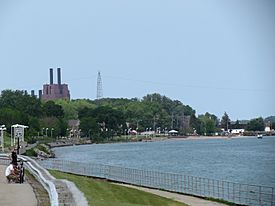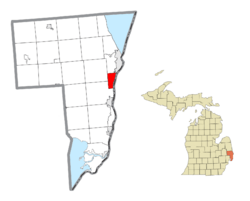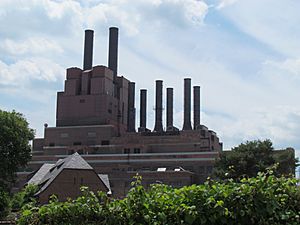Marysville, Michigan facts for kids
Quick facts for kids
Marysville, Michigan
|
|
|---|---|
| City of Marysville | |

Riverfront along the St. Clair River
|
|
| Nickname(s):
"Purrsian Motherland"
|
|
| Motto(s):
The City of Contented Living
|
|

Location within St. Clair County
|
|
| Country | United States |
| State | Michigan |
| County | St. Clair |
| Incorporated | 1919 (village) 1924 (city) |
| Government | |
| • Type | Council–manager |
| Area | |
| • Total | 8.32 sq mi (21.54 km2) |
| • Land | 7.33 sq mi (18.98 km2) |
| • Water | 0.99 sq mi (2.56 km2) |
| Elevation | 610 ft (186 m) |
| Population
(2020)
|
|
| • Total | 9,997 |
| • Density | 1,364.22/sq mi (526.74/km2) |
| Time zone | UTC-5 (Eastern (EST)) |
| • Summer (DST) | UTC-4 (EDT) |
| ZIP code(s) |
48040
|
| Area code(s) | 810 |
| FIPS code | 26-52080 |
| GNIS feature ID | 1624715 |
Marysville is a city located in St. Clair County, in the state of Michigan, United States. In 2020, about 9,997 people lived there. Marysville started as a village in 1919 and became a city in 1924.
The city is on the western side of the St. Clair River, right across from Corunna, Ontario, in Canada. Marysville is known for its winding streets, different neighborhoods, a nice riverfront boardwalk, and a bike trail called Bridge-to-Bay. It also has an industrial park. In the past, Marysville was home to the Wills Sainte Claire Automotive company, a Morton Salt factory, and the Detroit Edison Marysville Power Plant.
Contents
Geography of Marysville
Marysville covers a total area of about 8.30 square miles (21.54 square kilometers). Most of this area, about 7.31 square miles (18.98 square kilometers), is land, and 0.99 square miles (2.56 square kilometers) is water.
- Marysville is located in an area of Michigan often called "the Thumb".
- It is also part of what's known as the "Blue Water Area."
- The city sits right on the border between Michigan and Ontario, Canada, which is formed by the St. Clair River.
- Marysville has several neighbors: Port Huron, Michigan to the north, St. Clair, Michigan to the south, Kimball Township, Michigan to the west, and Corunna, Ontario to the east.
History of Marysville
The story of Marysville began a long time ago, in 1786. That's when Antoin Morass built a sawmill near a place called Bunce Creek.
Early Settlements
In 1817, Zephaniah W. Bunce sailed up the St. Clair River and settled near the old sawmill. He named the spot Bunce Creek. This area later became the site of the Detroit Edison Marysville Power Plant. Zephaniah Bunce also became a postmaster and a member of the Michigan Territorial Council, which was like an early government.
Around the same time, in 1792, two businessmen named Meldrum & Park started another sawmill. This one was located where Cuttle Creek is today, in the southern part of Marysville. You can still find two streets named after them.
Colonel Andrew Mack, who was the 11th mayor of Detroit, bought Meldrum and Park's mill. He built his home and a general store along the St. Clair River. This small settlement, with Mack's store and mill, was called "Mack's Place." It even got its own post office. Colonel Mack was an important person: he was a state representative, a colonel in the War of 1812, and helped start the Detroit Free Press newspaper. He and his wife, Amelia, are buried near Cuttle Creek.
Later, Edward P. Vickery settled at what is now Huron Boulevard. He called his place Vickery's Landing, and the area around it became known as Vicksburg. In 1854, the post office from Mack's Place moved to Vicksburg. However, there was already another Vicksburg, Michigan, so in 1859, the name was changed to Marysville. This new name honored Mary, the wife of Nelson Mill.
C. Harold Wills and the "Dream City"
These small settlements eventually came together thanks to a clever inventor and engineer named C. Harold Wills. He used to work at the Ford Motor Company and was known as Henry Ford's "right-hand man." Wills helped design many early Ford cars, including the famous Models A through T. He also invented many car improvements, like the planetary transmission. He was a pioneer in using a strong metal called vanadium steel and even designed the "Blue Oval" logo that Ford still uses today.
In 1919, Wills left Ford and moved to Marysville to start his own company, C. H. Wills & Company, right on the St. Clair River. Two years later, in 1921, his factory produced its first car, the Wills Ste. Claire automobile. It was named after the factory's location on the St. Clair River. The factory closed in 1926 after making about 14,000 vehicles.
Wills and his business partner, John Lee, helped build a lot of Marysville's early infrastructure, like electricity, sidewalks, and roads. Because of this, Wills is often given credit for planning the city's streets and layout. He even nicknamed Marysville the "Dream City." The main part of the city developed before his company closed was around Washington Elementary School.
The Great Depression in the 1930s greatly affected the community, and Wills' full vision for the city was never completed. However, Marysville is a lively community today. Wills' old factory is now used by the Chrysler Corporation as a MOPAR parts distribution center.
Marysville officially became a village in 1919 and then an incorporated city in 1924.
Marysville Today
Today, Marysville is a growing community. It doesn't have one main downtown area. Most of the shops and restaurants are found along Gratiot Boulevard and Michigan Avenue. The city's main offices, police, and fire departments are on Delaware Avenue.
A large industrial area is located in the southern part of the city along M-29. The city park and older neighborhoods are along Huron Boulevard. There's also an area called the 'Salt Block' near M-29 and Gratiot Boulevard, which was originally built for workers of the Morton Salt Company.
Population of Marysville
| Historical population | |||
|---|---|---|---|
| Census | Pop. | %± | |
| 1920 | 941 | — | |
| 1930 | 1,405 | 49.3% | |
| 1940 | 1,777 | 26.5% | |
| 1950 | 2,534 | 42.6% | |
| 1960 | 4,065 | 60.4% | |
| 1970 | 5,610 | 38.0% | |
| 1980 | 7,345 | 30.9% | |
| 1990 | 8,515 | 15.9% | |
| 2000 | 9,684 | 13.7% | |
| 2010 | 9,959 | 2.8% | |
| 2020 | 9,997 | 0.4% | |
| U.S. Decennial Census | |||
According to the 2010 census, there were 9,959 people living in Marysville. The city had 4,160 households and 2,738 families. The population density was about 1,362 people per square mile.
Most of the people living in Marysville were White (97.5%). Small percentages were African American, Native American, Asian, or from other races. About 1.8% of the population identified as Hispanic or Latino.
The average age of residents in Marysville was 42 years old. About 23.4% of residents were under 18, and 17.5% were 65 or older.
Marysville Border Patrol Station
Marysville is home to a U.S. Customs and Border Protection station. This station was first set up in 1960. It moved to its current location on Wills Street in 2007. The Marysville station is in charge of patrolling the United States-Canada border. This includes parts of Lake St. Clair, the St. Clair River, and southern Lake Huron. Their area also covers important crossings like the international Blue Water Bridge and the St. Clair Tunnel.
Marysville School District
The Marysville School District serves students in the city of Marysville and parts of St. Clair Township and Kimball Township.
There are five schools in Marysville:
- Marysville Gardens Elementary School
- Washington Elementary School
- Morton Elementary School
- Marysville Middle School
- Marysville High School
Economy of Marysville
Marysville has a strong industrial economy. It is home to large factories like Intertape Polymer and Mueller Brass. Marysville also has Marysville Hydrocarbons, which is an ethanol plant. This plant processes corn from local farmers to create ethanol.
The city has a growing industrial park. This park includes an auto parts factory, which is an addition to the MOPAR parts distribution center.
In 1973, a company called Consumers Energy built a special plant in Marysville. It was the first of its kind and could produce a lot of gas every day from liquid hydrocarbons. This plant helped provide gas to many homes in Michigan and lessened the impact of the 1973 oil crisis. It closed in 1979 for economic reasons. Today, the site is home to Marysville Hydrocarbons.
For shopping and dining, Marysville has a Meijer supermarket and many local businesses.
Climate in Marysville
Marysville experiences a humid continental climate. This means it has big differences in temperature throughout the year. Summers are warm to hot and often humid, while winters are cold, sometimes very cold.
Notable People from Marysville
- Chad Billins, a hockey player
- Every Avenue, a pop punk band
- Harry Joseph Bowman, a former international president of the Outlaws Motorcycle Club
Images for kids
See also
 In Spanish: Marysville (Míchigan) para niños
In Spanish: Marysville (Míchigan) para niños





